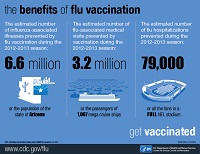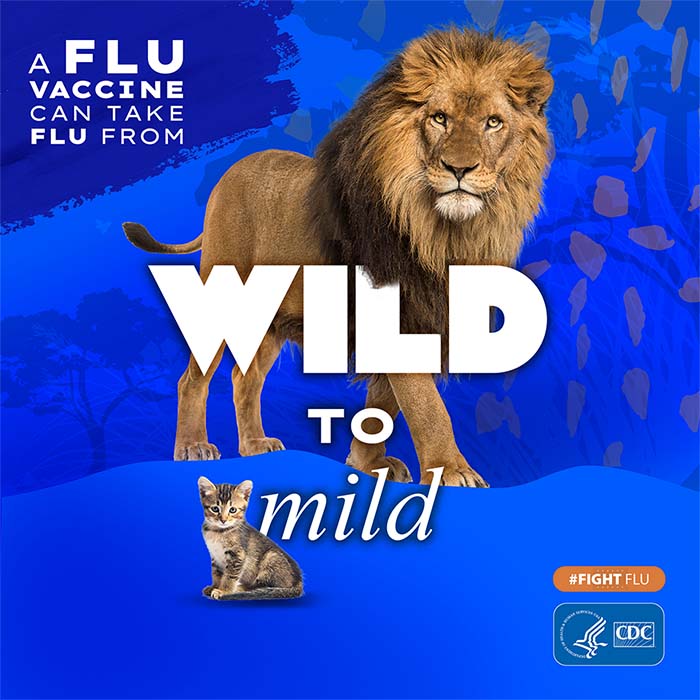New Report Cites Benefits of Flu Vaccine Yet More Than Half of Americans Remain Unvaccinated
During National Influenza Vaccination Week, CDC Urges As Yet Unvaccinated Americans to Get A Flu Vaccine
December 12, 2013 — A new report released by the Centers for Disease Control and Prevention (CDC) today during National Influenza Vaccination Week (NIVW) highlights the benefits flu vaccine can provide, estimating conservatively that influenza vaccination prevented 79,000 hospitalizations and 6.6 million illnesses last season. The report also underscores how severe flu can be; it includes an estimate that 381,000 Americans were hospitalized from the flu last season. Despite the benefits of vaccination and the potential severity of the flu, CDC also announced that fewer than half of Americans have gotten vaccinated so far this season. The agency hopes this information will encourage people who are still unvaccinated to get their vaccine before the 2013-2014 flu season takes off.
The 2012-2013 influenza vaccine program impact data was released in a Morbidity and Mortality Weekly Report (MMWR) dated December 13, 2013. In this report, CDC used a model first published in June 2013 in PlosOne to estimate the number of influenza-associated illnesses (6.6 million), medically attended illnesses (3.2 million) and hospitalizations (79,000) that were prevented last season as a result of flu vaccination. The report also includes estimates for the numbers of influenza-associated illnesses (31.8 million), medically attended illnesses (14.4 million) and hospitalizations (381,000) that occurred during 2012-2013.
These are the greatest benefits from vaccination estimated by using this model when looking back retroactively as far as 2005-2006. These high numbers are largely attributable to the severity of the season. This is because vaccination prevents more illnesses during seasons with high intensity and less during seasons of lower intensity since fewer influenza cases can be prevented when the underlying amount of disease is low.
These estimates represent a 17% reduction in the number of flu illnesses and hospitalizations that would have occurred last season in an unvaccinated population. According to the report, vaccination last season had the greatest benefit on those who are most vulnerable to the flu: children younger than 5 and people 65 and older. An estimated 69% of the prevented hospitalizations were among children aged 6 months-4 years and persons 65 years and older. An estimated 69% of the prevented hospitalizations were in people in these two age groups.
The report concludes that while vaccination produced a substantial reduction in influenza-associated illness last season, there are additional benefits that could be realized through increased vaccination coverage and improvements in the effectiveness of existing vaccines. The MMWR report estimates that if vaccination levels had reached the Healthy People 2020 target of 70%, approximately 4.4 million additional illnesses, 1.8 million additional medically attended illnesses, and 30,000 additional hospitalizations might have been prevented.
The estimates released by CDC today are one example of ongoing efforts across the agency to better measure the impact of public health interventions. CDC will continue to refine the methodology for estimating the impact of influenza vaccine as an active, ongoing research agenda continues to inform the process. There is information suggesting that current estimates on the number of hospitalizations that occur annually are low. Further refinements in the model may change estimates in the future.
CDC released this information in concert with NIVW, a national observance taking place from December 8-14, 2013. Past flu vaccination coverage estimates have shown flu vaccination activity drops quickly after the end of November. NIVW was established by CDC in 2005 to underscore the importance of continuing flu vaccination through the holiday season and beyond.
The national early season vaccination coverage reports also released by CDC today estimate that only 39.5% of people 6 months and older had received a flu vaccination by early November. Early estimates from last season were that 36.5% of people had reported getting a flu vaccination by early November.
Other online coverage reports indicated that vaccination among pregnant women (40.7%) and health care providers (62.9%) also is about the same as it was this time last year. Among health care providers, the agency again noted high vaccination rates among clinical providers like pharmacists (89.9%) and physicians (84.3%) but much lower vaccination rates among assistants or aides (49.2%) and health care providers working in long-term care facilities (52.6%). These preliminary estimates are calculated using data from telephone and online surveys and are subject to some limitations. Final estimates will be calculated after the end of the flu season.
Since 2010, CDC and the Advisory Committee on Immunization Practices (ACIP) have recommended everyone 6 months and older with rare exception get a yearly flu vaccination. Vaccination is especially important for people who are at high risk of serious flu-related complications, including young children and people 65 and older, pregnant women, and people with certain chronic medical conditions, like asthma, diabetes and heart disease. CDC also recommends that health care providers get vaccinated annually.
CDC recommends that providers continue to provide flu vaccinations throughout the flu season, which can last as late as May. Today, the agency stressed the importance of ongoing vaccination efforts to increase vaccination coverage, particularly in groups that are lagging in their coverage levels, and noted the importance of a clinician recommendation and offer for vaccination as a motivating factor for people to get vaccinated.
While the MMWR report focused more on the preventive benefits provided by vaccination, an important underlying message of this report is the high burden of illness flu can cause. While flu seasons vary in intensity, last season was characterized as moderately severe overall, but was severe for seniors. The MMWR report indicates that an estimated 381,000 hospitalizations occurred during 2012-2013. This is the highest estimate for the number of flu-associated hospitalizations for a single flu season derived using this model, including during the 2009-2010 season, when 290,000 hospitalizations are estimated to have occurred during that first season of the H1N1 pandemic.
The 381,000 estimate also tops the frequently cited “more than 200,000 flu-related hospitalizations” that are said to occur each season. This estimate is taken from a different study that averaged data from the 1990s. In that study, estimates for hospitalizations during individual seasons ranged from a low of 158,000 estimated hospitalizations in 1990-1991 to a high of 431,000 estimated hospitalizations during 1997-1998, underscoring the extreme variability that can occur from one season to another.
According to CDC data, hospitalizations during 2012-2013 were driven largely by high hospitalization rates among people 65 and older who were hard-hit by the H3N2-predominant season. Based on hospitalization data collected from the Influenza Hospitalization Surveillance Network, people 65 and older had a hospitalization rate of 182/100,000 during 2012-2013. Data from the same surveillance system showed that the hospitalization rate for people 65 and older has ranged from 14.2/100,000 to 75.9/100,000 over the six influenza seasons from 2005-2006 to 2011-2012. During 2009-2010, hospitalization rates among people 65 and older were relatively low (31.6/100,000), probably because many older people had some pre-existing immunity to the H1N1 pandemic virus.
Other markers for severity were elevated last season as well. For example, CDC recorded the highest number of reported influenza-associated deaths among children (169) in a non-pandemic season since this type of reporting began in 2004. Estimates for illnesses and medically attended illnesses during 2012-2013 in this report were elevated as well, but well under the numbers seen during 2009-2010, when an estimated 52 million influenza illnesses and 24 million medically attended illnesses occurred. During 2009-2010, hospitalization rates were highest among children 6 months to 7 years of age (71.7/100,000).
The CDC MMWR report concludes with a reminder that while the timing of influenza activity is unpredictable, peak weeks of flu activity have occurred in January through March during 90% of the past 20 seasons. The latest FluView surveillance report indicates that flu season is just starting. For the millions of American who have not yet been vaccinated this season, that means there is still time to be protected against the flu this season. There are several flu vaccine options for the 2013-2014 flu season. Use the Healthmap Vaccine Finder to find a flu vaccine location near you.

